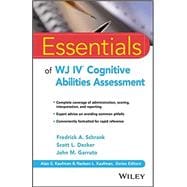Essentials of WJ IV® Cognitive Abilities Assessment provides expert, practical advice on how to administer, score, and interpret the WJ IV COG®. Designed to be an easy-to-use reference, the text goes beyond the information found in the WJ IV® examiner's manual to offer full explanations of the tests and clusters on the WJ IV COG®. This essential guide also explains the meaning of all scores and interpretive features and includes valuable advice on clinical applications and illuminating case studies.
This clearly written and easily accessible resource offers:
- Concise chapters with numerous callout boxes highlighting key concepts, numerous examples, and test questions that help you gauge and reinforce your grasp of the information covered.
- An in-depth chapter on interpretation of the WJ IV COG® which highlights links to interventions for each test based on contemporary theory and research.
- Expert assessment of the tests' relative strengths and weaknesses.
- Illustrative case reports with clinical and school-based populations.
If you're a school psychologist, clinical psychologist, neuropsychologist, or any professional or graduate student looking to become familiar with the new WJ IV COG®, this is the definitive resource you'll turn to again and again.








